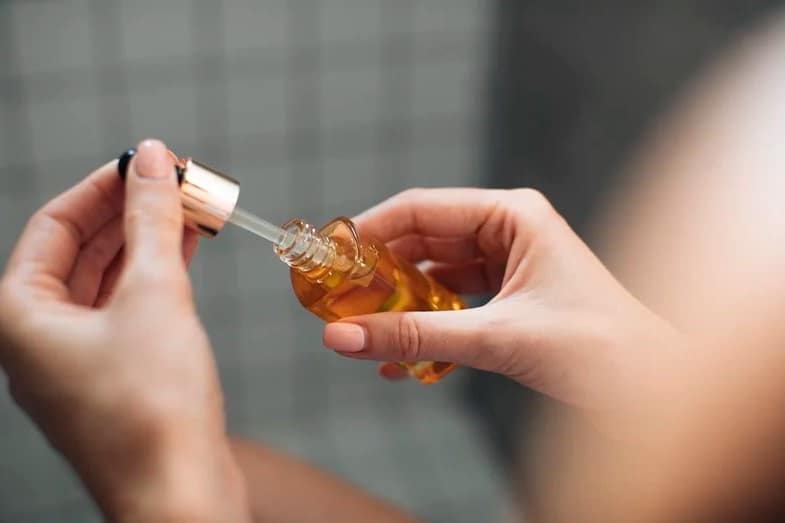Retinol and niacinamide are two very popular and effective ingredients in skincare products. They each have their own positive effects and benefits on the skin that experts and beauty gurus swear by.
But how effective are they if combined? Is using retinol and niacinamide together even safe, or are they best used separately?
Can you use retinol and niacinamide together? It is safe and beneficial to use retinol and niacinamide together on your skin. It is becoming more common for niacinamide to be added to retinol products as it helps keep retinol’s intense effects (such as irritation) more bearable.
Simply put, niacinamide and retinol complement each other when both are used together or layered as part of a skincare routine.
To understand better how these two ingredients can be combined, let’s learn what they are and how they benefit the skin individually.
Read on to learn more about using retinol and niacinamide together in skin care products.
Also, for an excellent that contains retinol, take a look at our top pick, the MDSolarSciences Evening Facial Repair Serum:
Click here to see it on Amazon.
Can You Use Retinol and Niacinamide Together?
Of all skincare combinations tried by specialists, one particular combination stood out above the rest, and it is – as they say – a match made in heaven.
Specialists consider the pairing of retinol and niacinamide a perfect skincare pairing as they complement each other to provide the best results for common skin conditions, such as acne and aging.
You don’t really need a full chemistry degree to understand how it works and benefits your skin. To put it simply:
First, niacinamide is an all-rounder when it comes to treating conditions, such as pigmentation, acne, redness, aging, and lack of hydration. The last bit, hydration, is a key feature.
Second, retinol is another all-rounder on its own when it comes to increasing skin cell turnover, leading to overall better skin health over time.
But the brute strength of retinol’s peeling properties can be harsh on the skin, as it damages the skin’s protective barrier and further loses moisture reserves on the surface.
That’s why niacinamide makes for a perfect partner to retinol!
Niacinamide can support the hard work being done by retinol through stabilizing the skin’s barrier, minimizing water, and moisture loss, which leads to an increase in overall hydration.
This process is attributed to niacinamide’s work in increasing natural lipids in the outermost layer of the skin (stratum corneum). This layer blocks off pollutants very effectively through its ‘brick-and-mortar’ structure.
Skincare products with both retinol and niacinamide are the go-to ways when it comes to treating a long list of skin conditions–without having to worry if a single product can be mixed with another.
Skincare experts like Dr. Sam Bunting recommend and have even come up with their own line of skincare products with this winning combination in their formulation. [1] This way, consumers will get the best results without having to do trial and error and risking additional damage to the skin.
Certain considerations are still required when it comes to using products that contain retinol or niacinamide. For example, an essential factor to consider when layering skincare products would be their pH levels.
What Exactly Is pH?
pH is a scale from 0 to 14, used to indicate how acidic or basic a specific solution is. The ideal pH level for healthy skin is at a range of 4.0 to 5.5.
As for retinol, the optimal pH level is around 5.5 to 6.0, while niacinamide is most efficient at the pH level of 5.0 to 7.0. This overlap in pH levels means the ingredients must not alter the pH of the other, or you could risk losing the effectiveness of one component while also risking damage to your skin.
By choosing a clinically tested product already containing both retinol and niacinamide, you can be sure that the correct amounts have been considered to create the formulation that would provide your skin with the best-intended results.
When and How to Use Retinol and Niacinamide

Research studies on the use of retinol and niacinamide together have resulted in several best practices over the years, such as:
- Pre-treating the skin with a niacinamide product before starting a retinol treatment will help reduce the chances of developing irritation from retinol.
- The long-term use of skincare products containing niacinamide, such as moisturizers, can significantly affect how the skin reacts once a retinol-based procedure is started.
The use of retinol and niacinamide together is proven to be a match made in skincare heaven, but it does not mean you cannot reap its combined benefits if you use it separately. Since both ingredients benefit the skin in the long term, experts suggest the two techniques below:
- Boost your skin’s strength and hydration by prepping your skin with a niacinamide-rich moisturizer for a couple of weeks before starting a retinol treatment. This vital step will reduce irritation and damage to the skin barrier.
- Niacinamide is water-based, while retinol is oil-based. And so it is best to apply a niacinamide product BEFORE application of a product containing retinol. The reason is that a water-based ingredient is faster absorbed by the skin and will already be working its magic by the time you apply retinol.
But if you are not into layering skincare products, you can check out the MDSolarSciences Evening Facial Repair Serum, which already contains both retinol and niacinamide in one expertly crafted lightweight formulation.
Click here to see it on Amazon.
It already has near-prescription strength retinol to even out skin tones, including niacinamide and caffeine in the mix to help soothe the skin while repairing existing skin surface damage.
Retinol Facts
Retinol is a synthetic derivative of vitamin A, which is commonly found in carrots, sweet potatoes, and eggs. It is considered the gold standard in skincare due to its anti-aging and skin-renewing benefits, among a whole lot more.
It is a potent retinoid, which may be tolerable for most, but may irritate already dry or sensitive skin due to its peeling properties.
Benefits of Retinol
Retinol lives up to its reputation by having loads of benefits to the skin, especially when applied topically. Some of its best benefits pertain to its most raved anti-aging properties. These benefits include the following:
- Retinol works by preventing new wrinkles from surfacing due to its minimizing effect.
- It smoothens out existing fine lines and wrinkles.
- It fades darkened age spots, hyperpigmentation, and sunspots, leading to a more even complexion over time.
- It helps exfoliate on a cellular level, which then brightens and smoothens dull skin.
- It can minimize breakouts by regulating oily skin.
Retinol can help treat usual skin conditions, but caution must be observed for those with sensitive or dry skin. Too much retinol can cause severe irritation, which is why it is best to use clinically tested and physician-recommended products.
One product that delivers visible results is the Paula’s Choice RESIST Intensive Wrinkle-Repair Retinol Serum. It has a gentle 0.1% retinol concentration that is clinically proven to firm up the skin while evening out the skin tone.
Click here to see it on Amazon.
It also has squalane, which is a potent source of antioxidants and essential fatty acids, including vitamin E that helps restore your skin’s radiance.
Niacinamide Facts
Niacinamide, also called nicotinamide, is a form of vitamin B3, which is an essential nutrient found as trace amounts in many different foods, such as meat, fish, nuts, and mushrooms.
Niacinamide is a complementary nutrient that helps in two major ways:
- It boosts the production of ceramide, which can make the skin structure more robust, providing better tolerance to skin irritants and pollutants.
- Niacinamide gives off anti-inflammatory properties that can lessen the adverse effect of starting a regimen that includes a strong retinoid, such as retinol.
Benefits of Niacinamide
Niacinamide works well with naturally occurring substances in the skin by breathing out new life to an otherwise dull and lifeless surface. Because of everyday environmental damage, our skin can feel rough, aged, and less radiant. Niacinamide in skincare products can be beneficial to your skin in the following ways:
- It can visibly minimize and tighten enlarged pores.
- It can soften fine lines and wrinkles.
- It repairs signs of old skin damage.
- It can help improve the skin’s barrier against skin pollutants.
- It promotes better hydration and retention of moisture on the skin surface.
If you feel the need to boost hydration and moisture in your skin, you can check out the Nia 24 Intensive Recovery Complex. This product is an intensive correcting and moisturizing cream for sun and age damage.
Click here to see it on Amazon.
It contains a hefty amount of niacinamide in its formulation. You can be sure to get fuller and firmer skin with continued use.
Niacinamide seems to do everything well when it comes to skincare. Imagine what it can do when niacinamide and retinol are paired together.
What Not to Mix with Retinol or Niacinamide
By now, we already know that retinol and niacinamide make an excellent skincare pairing. So, what are the ingredients that you should avoid, especially when you’re already using these two products?
Remember that you have to take into account your skin type and any skin condition before starting a new skincare routine.

1. Retinol and AHAs (e.g., Glycolic Acid) and BHAs (e.g., Salicylic Acid)
- Retinoids, such as retinol, must never be mixed with AHAs and BHAs as these acids can inactivate the effectiveness of retinoids.
- Mixing retinol with acids can cause excessive skin irritation and dryness.
- AHAs or BHAs mixed with retinol may potentially damage the moisture barrier of the skin.
2. Retinol and Vitamin C
Retinol used with vitamin C can increase the skin’s sensitivity to the sun’s rays, putting you at a higher risk of burns and UV damage.
Pro Tip: If you still wish to use both ingredients, it’s best to use a product with vitamin C during the day and a retinol-based product at night.
3. Niacinamide and Vitamin C
Niacinamide cancels out the good components of vitamin C and converts them to redness and acne-inducing properties. But when they are used separately and never at the same time, these ingredients can be of great help in treating scarred and blemished skin.
Conclusion – Can You Use Niacinamide and Retinol Together?
So, to revisit the initial question: Can you use retinol and niacinamide together? Yes, using niacinamide and retinol together is entirely safe and beneficial for your skin.
These two ingredients are already considered the gold standards in skincare in their own right. So, using them together makes for a perfect combination! Niacinamide flawlessly matches the rather harsh functioning of retinol on your skin.
Dryness and irritation may occur with retinol’s anti-aging and peeling properties, especially for people with sensitive or dry skin. But with the help of niacinamide’s hydrating properties, moisture can be further locked into the skin’s surface, blocking potential irritants, including retinol’s own.
With new and better skincare technology available today, you can be sure to find the right fit for your skin type and existing skin conditions. There are products with only retinol or just niacinamide for you to try if you already have an existing routine.
However, some products contain the winning combination of retinol and niacinamide to give your skin the best of both worlds!
According to experts, retinol and niacinamide serums are best used at nighttime when your skin has a lot of time to breathe and renew.
Remember that skincare products take some time to be absorbed into the skin, and nighttime is the best time to reap the benefits of these two excellent ingredients.





![Read more about the article Radio Frequency Skin Tightening [Complete Guide]](https://skincaregeeks.com/wp-content/uploads/2020/02/radio-frequency-skin-tightening-300x200.jpg)
